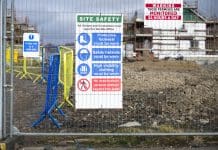40 construction workers died in 2019-20, as the fatality rate sits around four times higher than the all industry rate, according to HSE’s annual workplace fatality figures
The Health and Safety Executive (HSE) has today (1 July) released its annual figures for the number of work-related fatalities in 2019/20, as well as the number of people known to have died from the asbestos-related cancer, mesothelioma, in 2018.
The annual data for work-related fatalities revealed that 111 workers were died at work between April 2019 and March 2020 (a rate of 0.34 deaths per 100,000 workers), the lowest year on record
40 fatal injuries to construction workers were recorded, accounting for the largest share. However, over the last five years the number has fluctuated. The annual average for the past five years is 37. The annual average rate over the last five years in construction is around 4 times as high as the all industry rate.
A time to reflect
Following the release, HSE’s chief executive, Sarah Albon, said: “No one should be hurt or killed by the work they do. In these extraordinary times, we have seen many workers risking their lives to help others during the coronavirus outbreak.
“Although these statistics are not a reflection on Covid-19 related loss of life, it is a pertinent time to reflect.
“Every workplace fatality is a tragedy and while we are encouraged by this improvement, today’s statistics is a reminder that we cannot become complacent as we look to continue to work together to make Great Britain an even safer place to live and work.”
The new figures show the spread of fatal injuries across industrial sectors:
- 20 fatal injuries to agricultural, forestry and fishing workers – the lowest level on record.
- 5 fatal injuries to waste and recycling workers.
Albon added: “These statistics remind us that in certain sectors of the economy, fatal injury in the workplace remains worryingly high. Agriculture, forestry and fishing accounts for a small fraction of the workforce of Great Britain, yet accounted for around 20% of worker fatalities in the last year. This is unacceptable and more must be done to prevent such fatalities taking place.
“Work-related deaths fracture families, they shatter communities, and so many of them can be avoided.
“The work that HSE does is about more than numbers, we are continually working with duty holders to ensure that they assess and appropriately manage risk to their employees. These efforts are a vital part of keeping essential services going, particularly as duty holders adapt to the current circumstances.”
Breaking down the figures
The three most common causes of fatal injuries continue to be – workers falling from height (29), being struck by a moving vehicle (20) and being struck by a moving object (18).
The new figures continue to highlight the risks to older workers – 27% of fatal injuries in 2019/20 were to workers aged 60 or over, even though such workers make up only around 10% of the workforce.
In addition, members of the public continue to be killed in connection with work-connected accidents. In 2019/20 51 members of the public were killed as a result of a work-connected accident in HSE enforced workplaces and a further 41 occurred on railways.
Mesothelioma, which is contracted through past exposure to asbestos and is one of the few work-related diseases where deaths can be counted directly, killed 2,446 in Great Britain in 2018. This is slightly lower than the average 2,550 over the previous five years.














